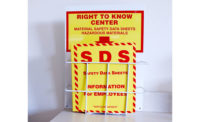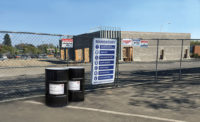
Hazard communication (hazcom) training problems continue to stymie many employers and keep OSHA inspectors busy. The hazcom rule has been around for more than a decade, but it still leads all other general industry safety regulations in the number of federal OSHA violations year after year (more than 4,200 in 2004/2005). Hazcom training alone accounts for one-quarter of all hazcom violations.
Why so many violations, and why does the same problem persist year after year? In 2004, Business & Legal Reports, in cooperation with the National Environmental Safety and Health Training Association (NESHTA), completed a survey of 828 EHS professionals who looked at environmental and safety training difficulties and challenges. Hazcom was the fourth most challenging topic to train from a list of 18 topics, with security/terrorism, emergency response and ergonomics more challenging. Budget limits, scheduling conflicts, time constraints and lack of employee acceptance of the training were the most challenging factors to overcome. Then there is the employees’ perspective. They are often confronted with posted hazard warnings, signs, tags, vendor labels, in-house labels, material safety data sheets (MSDSs) in many formats, manuals explaining the company hazard communication program, lists of chemicals, and safety information furnished by vendors, federal and state agencies, trade associations, and unions. This wide variety of information differs in format, content and reading level, which can confuse and obscure the core message. All the while, employees are trying to focus on their jobs.
Prove it to inspectors
It’s not enough to document that hazcom training has occurred; you have to prove to OSHA inspectors that your training is “effective.†OSHA’s Directive for Inspection Procedures for the hazcom standard (CPL 02-02-038) states, “Training programs must be evaluated through program review and discussion with management and employees. If the Compliance Safety and Health Officer [the OSHA inspector] detects a trend in employee responses that indicates training is not being conducted, or is conducted in a cursory fashion that does not meet the intent of the standard, a closer review of the written program and its implementation may be necessary.†It seems plausible that ineffective training programs prompted OSHA inspectors to find many of the 2,413 violations related to the written hazcom program in 2004/2005.How does OSHA interpret “effective†training? Effective means that employees must carry the knowledge from their training into their daily jobs. For example, if asked, every employee should know where the hazardous chemicals are in his or her work area, and how to find and read an MSDS and chemical label.
Reasons for failure
OSHA has identified a number of typical reasons hazcom training fails to be effective:- Poor performance by employees is not due to a lack of knowledge and skills, but to inadequate engineering controls.
- Training is too generic; instead of focusing on specific hazards in the workplace, some employers show only generic videos.
- Little attention is given to the specific needs and preferences of adult learners. For example, the use of technical terms in a presentation may turn off learners in a steel mill, yet may be appropriate for healthcare professionals.
- Inappropriate training methods and media are selected, such as relying on a slide show to demonstrate how to put on and take off personal protective equipment.
- There is no transfer of learning from the training setting to the job when the training is a “one-shot†deal, with no further follow-up in the work setting.
- There is no evaluation of training effectiveness, no way to know if employees achieved the level of knowledge and skill that was expected.
- Documentation of training is inadequate; it’s hard to know how to improve a training program if there is no record of past performance or effectiveness.
- Address the lack of understanding among employers of what kind of training is required.
- Address the lack of knowledge on how to conduct effective training.
Extract what you need
What’s different about this guidance manual compared with similar training guidance published by OSHA and other organizations? The 289-page OSHA manual is daunting at first glance. But 252 pages are appendices that contain a glossary, detailed modular sample lesson plans, presentations and quizzes. There are enough easy-to-read explanations, tables and checklists up front to make this manual worthwhile, and you will quickly see its value. It is designed so that you can extract only the modules you need to fill in gaps in your own program, or use the entire program as presented and fill in your site-specific information where appropriate.The first part of the manual describes how to set training goals and objectives, and includes a checklist for doing this job. It also offers suggested criteria for purchasing training programs from vendors. The guidance is developed around a detailed scenario of a small company that must build a hazard communication program from scratch for 20 employees using ten chemicals. The discussion is specific enough to suggest what to do when an employee falls asleep during a training lesson (switch to a question-answer format).
The appendices provide several sample lesson plans and how to use them effectively. The sample lesson plans provide the suggested duration of each “slide†or frame, the subject for the frame, what to do, and cues for moving through each phase of the lesson. The lesson plans and slide shows are divided into two groups: The first covers topics that help employees understand chemical hazards (the hazcom standard, MSDSs and labels), and the second group covers specific chemical categories (flammables and combustibles, corrosives, reactives and toxics).
One challenge with the manual is that it will require some formatting work to fit the material into your own software or print applications. Unlike many off-the-shelf vendor programs, it is not “camera ready†for presentation to an audience.
All the material in the guide is copyright-free; the entire manual is in the public domain and can be used without permission from OSHA. The agency just asks that you acknowledge it as the source of the material that you use.
Allow for questions
A final note concerning the use of “automated†media to conduct training: OSHA’s 2003 Directive for HAZWOPER enforcement (CPL 02-02-071) states, “In an effective training program, it is critical that trainees have the opportunity to ask questions where material is unfamiliar to them. In a computer-based program, this requirement may be met by providing a telephone hotline so that trainees will have direct access to a qualified trainer.â€This looks like a good policy to follow for effective hazcom training.
Written for Business & Legal Reports Inc. by Legal Editor David Galt. For more information, visithttp://safety.blr.com.
Sidebar: Helpful tool
OSHA’s hazcom training manual contains:- Instructions for designing and implementing a training program.
- Explanation of key terms in the hazcom standard.
- How-to-train checklists.
- Model lesson plan divided into topical modules with timeframes for completing each module.
- Model overhead slide show.
- Model multisection quiz.
- Additional help and references guide.


